Radicchio on My Mind
Gluten + Lactose-Free + Vegetarian. Two Warming Dishes for This Wonderful Winter Leaf
I know I should be writing about cookies or a cosy festive dish, but I have radicchio on my mind. We tend to think of the spring, summer, and early autumn as the height of fruit of the vegetable season. Still, as we turn into winter, the produce stands here in Italy are a tempting jewellery store case of winter greens, and I find the fruit of these displays so very hard to resist.
While spending a winter in Trento in my late 20s (I will always bang on about this time because we cooked our way through that winter with lots of regional ingredients that I had never experienced before opening my culinary mind in so many ways), my sister pal roasted a pan of Radicchio rosso di Treviso tardivo IGP (Indication of Geographic Protection) for lunch on a weekend afternoon to accompany an enviable fish. An elegant plant in shape and colour, with what you might call Liberty-style vibes, this cooking technique collapsed its silky tendrils into a brown-tinged mound. It was smokey and bitter with an exotic and uninviting texture, and although I did enjoy the new experience, I did not prefer it.
I don’t know about you, but I have a lifetime of hoarding recipes from magazines and Sunday rags. They hang around in cupboards, tucked into books and folders and more often than not, I make the odd recipe, fall in love with it, lose the clipping and get really annoyed at not being able to find it again.
That same winter I rolled into my pals retro yet still modern turquoise Miele family kitchen with various clippings under my arm. My friend’s mother Marcella, with family roots in the Veneto region, a home of modern radicchio cultivation, was happy to taste the results which came from their pages.
“Modern cultivation of the plant began in the fifteenth century in the Veneto, Friuli-Venezia Giulia and Trento regions of Italy.”
A roasted pumpkin salad recipe torn from the Irish Sunday Independent was one of her favourites, and I added another type of radicchio to the recipe determined to make this new ingredient my friend.
This warm winter insalatona returns to our kitchen yearly as the preferred late autumn/winter salad that supports my Greek Feta DOP problem. I search my memory for the ingredients (lost the clipping) to match the photo that I can see in my mind - frisée aka indivia ricca or curly endive (another member of the chicory family with a bittersweet flavour and mild peppery undertones), sweet roasted pumpkin, creamy salted feta and toasted pine nuts all topped with an orange vinaigrette — ingredients which create a balancing alchemy of flavour.
Another dish I prepared for her was a version of a leek pasta from Jamie Oliver that I started making on repeat while living in Dublin around this time. This recipe was inexpensive, easy to make, felt fancy and I could buy mascarpone at the little Italian grocery up the road from my flat in Ranelagh. In Trento, this recipe was also improved by the addition of radicchio and it also returns to our kitchen every year.
Here the harmony of sweet leek, creamy mascarpone, salty Parmigiano and Pecorino Romano held up by the foundation of a nutty whole-grain gluten-free pasta creates a similar and welcoming dynamic when radicchio joins the party.
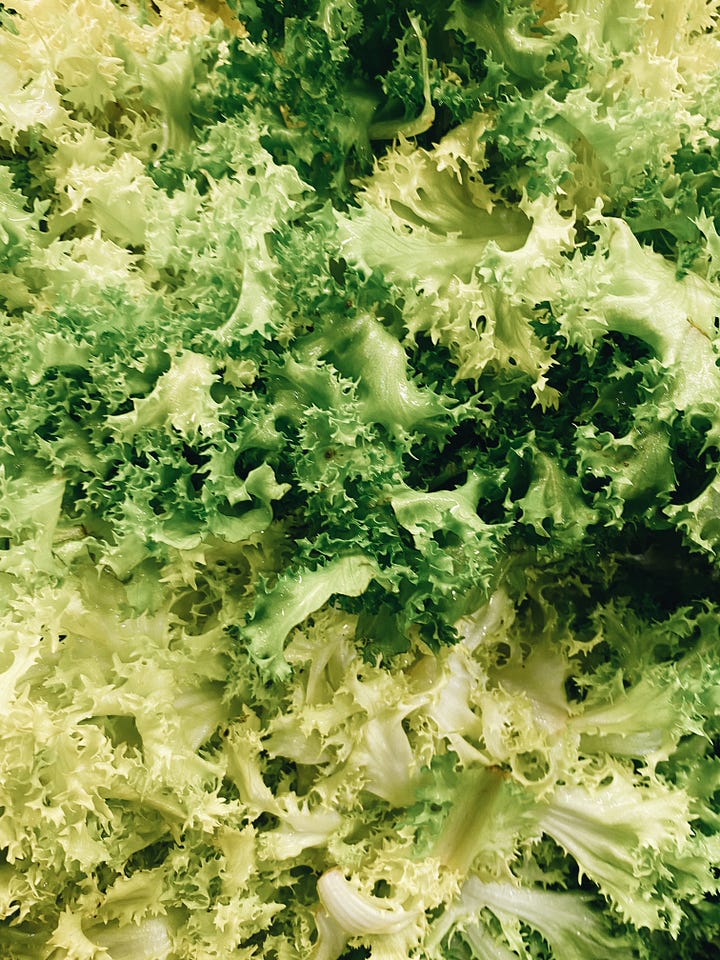
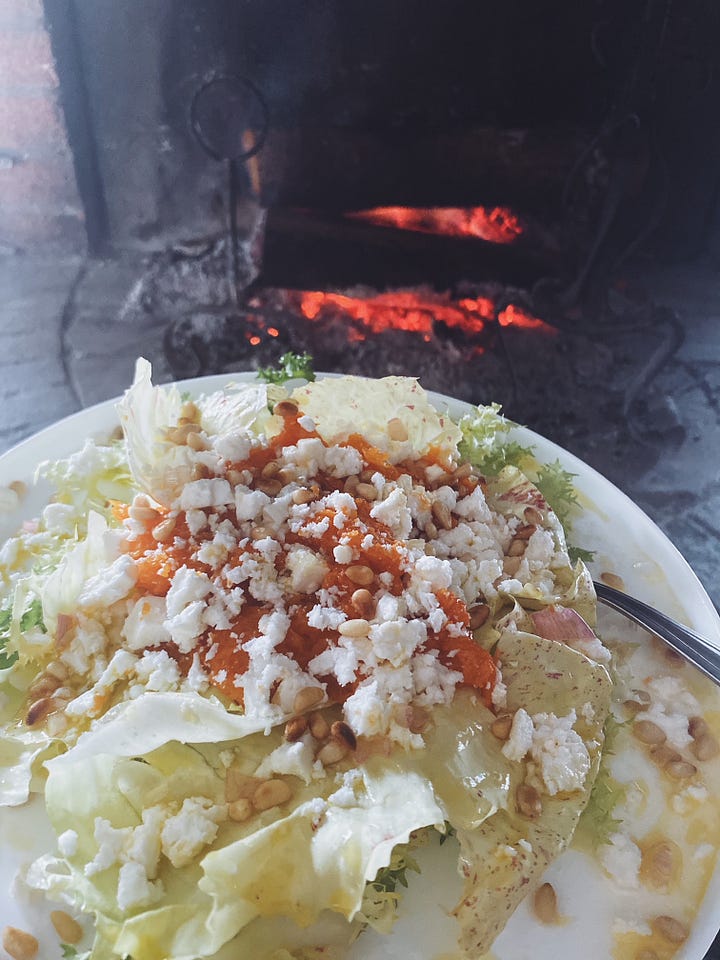
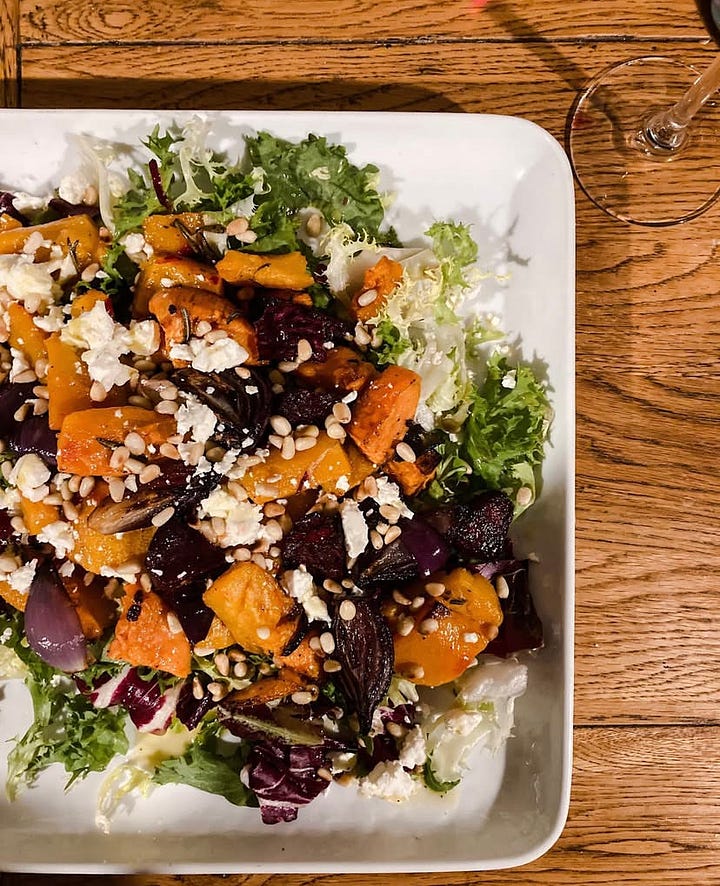

The various varieties of chicory will not please everyone due to their varying degrees of spicy and bitter notes. But like your Uncle Bob’s record collection, I think it can be an acquired taste and appreciation when treated right. It is difficult to avoid radicchio in Italy as a member of the Italian chicory family (Cichorium intybus, Asteraceae), and through the years recipes like these have exposed the softer more palatable ways of eating and cooking with this curative plant.
“Bitter-tasting foods have unique health benefits, including protection against cancer, heart disease and diabetes, as well as reduced inflammation and oxidative stress. Most of these benefits come from the wide array of polyphenols, which act as antioxidants, anti-inflammatories and even prebiotics.” - Healthline
Radicchio comes in different shapes and sizes and is mostly available through late autumn to early spring. The Radicchio rosso of Treviso tardivo (late) to which I was first exposed, is planted between June and July and harvested between November and April after undergoing a delicate and detailed transplanting and production process which leads to its perfection. Radicchio rosso di Treviso precoce (early) is grown entirely in the field. Its flavour is more bitter and pungent than its late curly friend and this is the leaf used in the pasta recipe below. The yellow and red speckled Radicchio di Castlefranco, a cross between Radicchio di Treviso and escarole has a creaminess that balances out the peppery curls of its companion in the salad.
This species is known for Vitamin K, which supports proper blood clotting and makes for an excellent source of bone support, together with other leafy greens. For these reasons, it is a beneficial choice for women heading into their later years, and it is also an ingredient of natural healing for those with celiac disease and other diagnoses which put you at a high risk for osteoporosis.
Radicchio offers a myriad of health benefits, but it is mainly recognized for its ability to support weight loss, eye health, blood pressure regulation, cognitive ability, digestion and bone health. --- Dove Medical Press
The two recipes below can be assembled in under 15 minutes (even 10 depending on the pasta you make). They are great for lunch or dinner, and can feed one or be extended to feed a small crowd. If at the end of this story, you decide that radicchio is not your thing or if you are finding it hard to come by where you are, I will offer some substitutes in the recipe notes below.
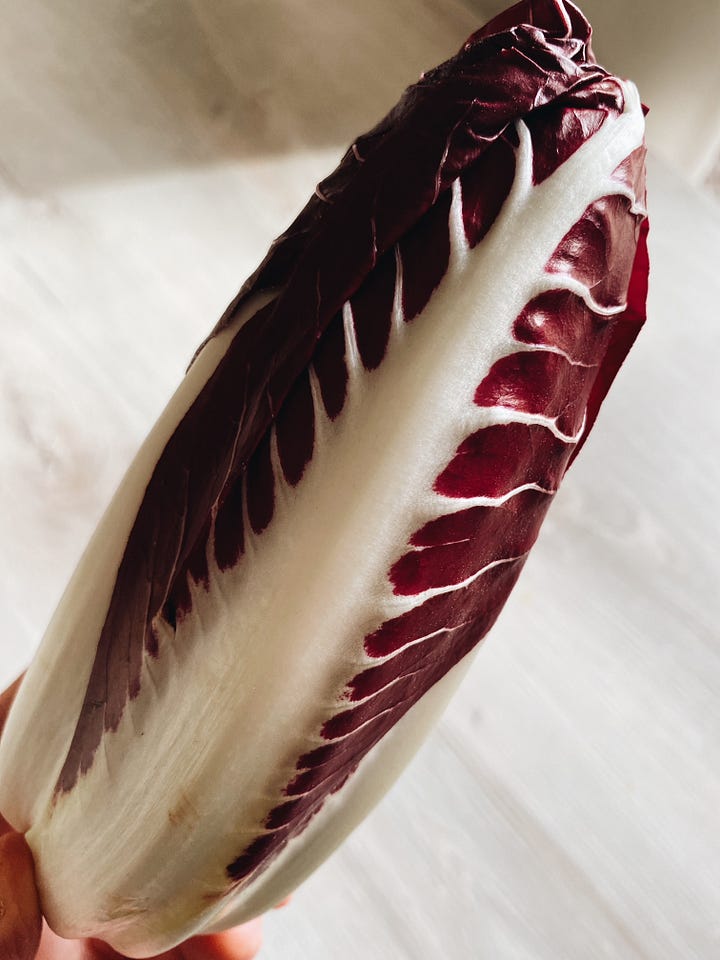

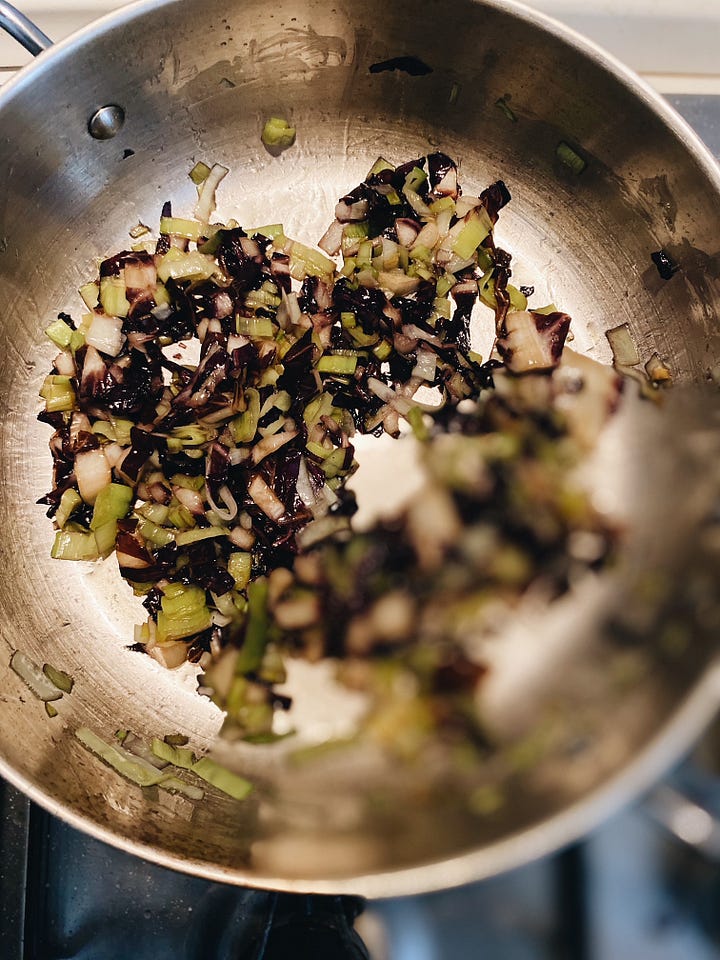

Where else can you use radicchio? Well, it also works great in a gentle risotto or as a filling for creamy crespelle. Others recommend it in stuffing for white meat and I have used individual leaves as beautiful little bowls for appetizers and antipasti. Apart from the ingredients used here, it pairs well with other Italian kitchen ingredients such as beetroot, fennel, pear and persimmon, hazelnuts, walnuts, and thyme as well as anchovies or tuna, pancetta or guanciale, both delicate and strong cheeses like Gorgonzola, gnocchi and polenta, capers and balsamic vinegar.
Radicchio is a unique and sophisticated ingredient that offers a world of culinary creativity. It makes for an interesting feature in a simple salad and it can stand up as the centre of attention at a dinner party. You might bookmark these recipes as something to try in the New Year, but the shapes, flavours and textures brought to the kitchen by the chicory family are a great way to elevate holiday menus and tablescapes. Never mind those cookies… Think radicchio. It just makes everything so damn pretty.
Roasted Pumpkin Salad with Radicchio, Endive and Feta
Insalata di zucca arrosto con radicchio, indivia riccia e feta
VE + GF + LF
Serves 2-4
Salad size is an objective thing. These measurements will give you two big salads as a main course or four smaller ones to complement other dishes on the table.
Ingredients:
1 generous handful of curly endive/frisée
1 generous handful of radicchio*
200g pumpkin or butternut squash
200g Greek Feta DOP, regular or lactose-free, crumbled
2 tbsp pine nuts, toasted
Extra virgin olive oil
Sea salt
Optional: 1 small pepperoncino crumbled, 2 tsp of runny honey
For the dressing:
5 tbsp extra virgin olive oil
2 tbsp apple cider vinegar
3 tbsp fresh orange juice + 1 tsp of zest
1/2 small shallot finely chopped
Optional: 2 tsp runny honey
Sea salt
Method:
Turn on your oven to 200 °C. Peel and large dice your pumpkin. Toss it with a good drizzle of olive oil, the honey and add the peperoncino here if you wish. Season with salt. Roast until soft and slightly browned 15-20 minutes.
Wash and dry your salad.
Make your dressing by combining all the ingredients in a small jam jar. Shake to emulsify.
Dress your plates with the salad leaves, top with the warm pumpkin and Feta, then drizzle the plate/s with salad dressing before adding your pine nuts.
Notes:
You can roast your pumpkin beforehand. If you can’t be bothered to peel it, you can roast it whole to easily remove the peel once cooked. Warm before serving.
Peperoncino gives the pumpkin a nice little kick if it is tolerated by those enjoying this dish.
In the place of Greek Feta DOP, you might try Italian ricotta salata.
Version II:
When we were living in Ireland full-time, radicchio was one ingredient that I really missed. It was only available in our rural location as the already chopped highlight of the bagged salad imported from Italy. During this time, I think I suffered from a rare case of radicchio/chicory family envy as I watched others spinning out tempting dishes with the various varieties of this ingredient. To help my bagged salad situation I roasted fresh beetroot (which I have not come by here in Central Italy), pumpkin, purple onions, chopped sage, a sprig of rosemary and a few cloves of crushed garlic together with a few glugs of olive oil. The warm syrupy charred sweetness of these vegetables, together with the indicated ingredients, also made for another interesting version of this salad.
Pasta with Radicchio, Leek and Mascarpone
Tortiglioni al radicchio, porro e mascaropone
Serves 2
VE + GF + LF
Ingredients:
200g pasta, regular or gluten-free
1 medium leek, thinly sliced
250 g of radicchio, finely sliced into ribbons*
125g mascarpone, regular or lactose-free
20g of finely grated Parmigiano Reggiano and/or Pecorino Romano combined
Extra virgin olive oil
Sea salt
Optional: a small knob of butter, regular or gluten-free
Method:
Bring a medium-large pot of water to a boil. Add a small handful of salt and add your pasta when it comes back to a boil. Reserve about 1/2 cup of cooking water and cook the pasta until al dente.
Thinly coat the bottom of a frying pan with olive oil, add a small knob of butter if you wish. Add your leeks and cook over medium-low heat until they are translucent, taking care not to burn. Add your radicchio, stir the vegetables to combine, season and cook for 3-5 minutes until the radicchio softens.
Turn the heat down low and add your mascarpone. Gently stir to combine with the vegetables and close the heat once it has melted into a smooth cream.
Drain your pasta and stir it into the cream adding a few splashes of cooking water to loosen. Add half of your grated cheese and continue stirring. Plate the pasta immediately and sprinkle it with the rest of the cheese to serve.
Notes:
A few generous leaves of finely sliced cavolo nero make a nice addition or substitute for the radicchio.
I used Radicchio rosso di Treviso IGP precoce here but Radicchio di Verona, Chioggia (towns of their cultivation) or Rosa can also work here.
This condimento would also suit other whole-grain paste corte such as penne, rigatoni, mezze maniche or even buckwheat pizzoccheri. Tagliatelle and pappardelle as paste lunge will work too.
The portion offered here is for a main course. Reduce to 70/80 grams as a first course.





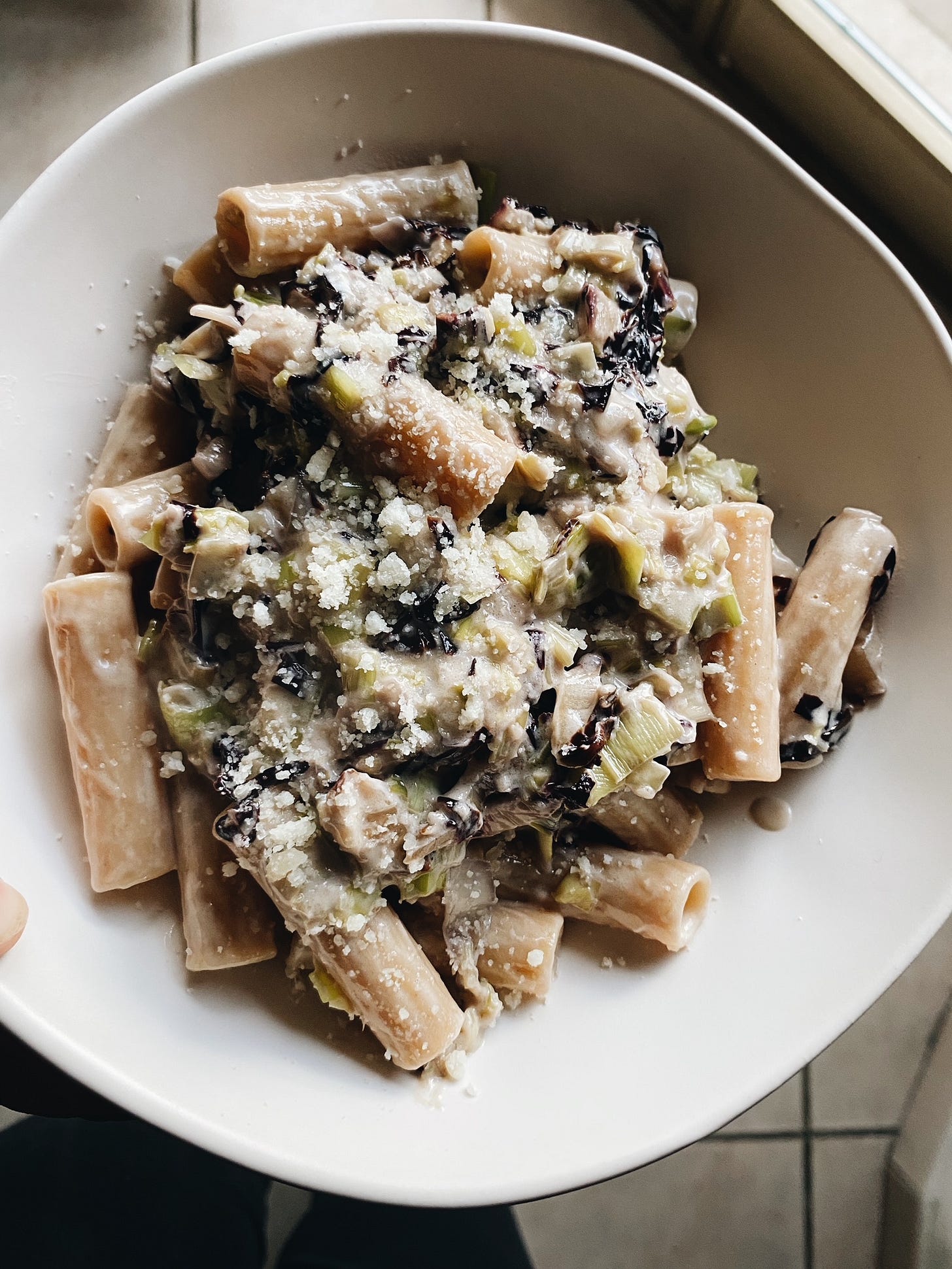

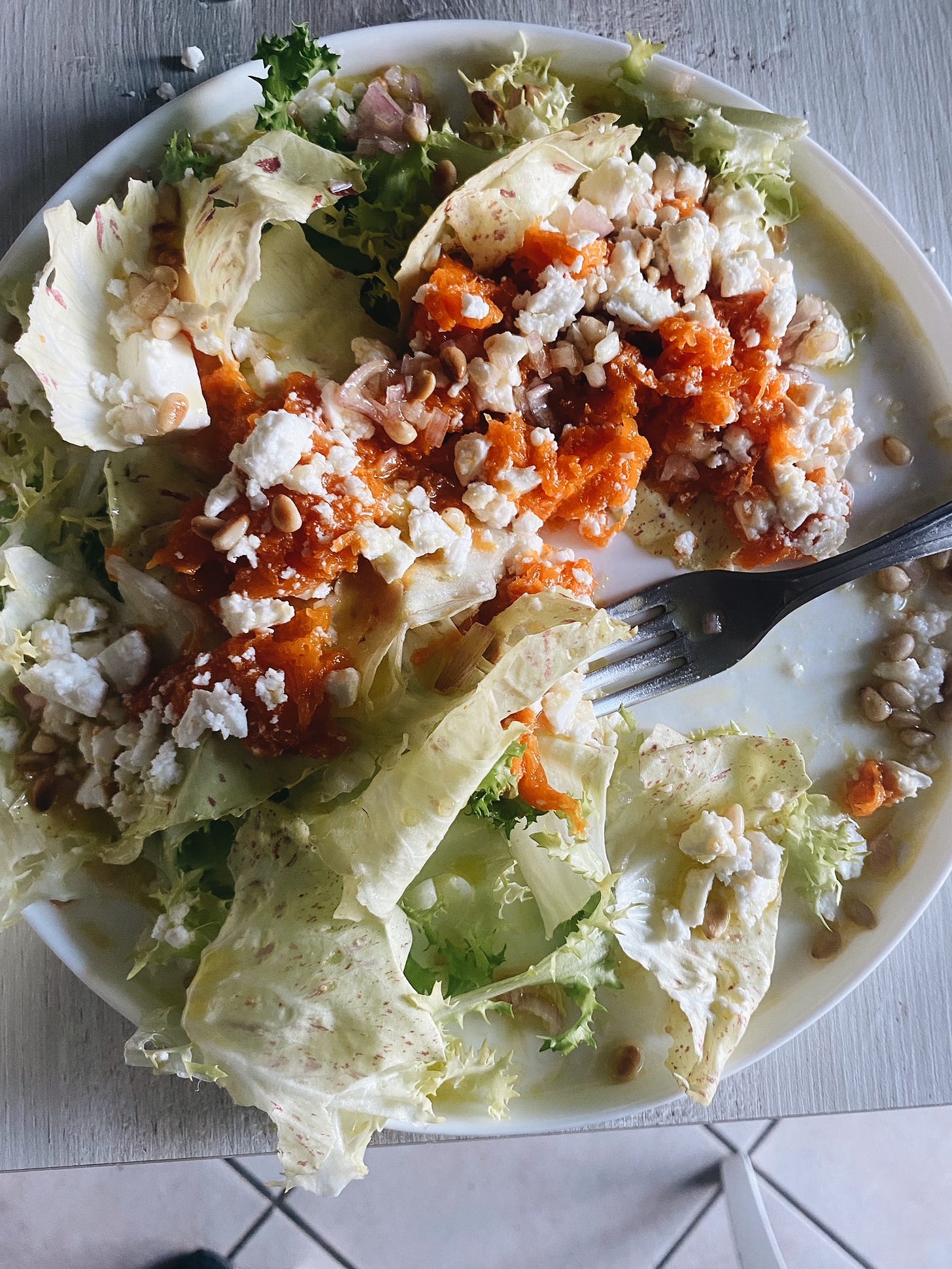


Thank you for reminding me about this too! We have it here in France, and it grows locally. Yet it's such an Italian thing to me that I somehow can't put it in context. Yesterday I saw real radicchio di Treviso and I almost bought it. Next time I'm at the farmer's I'll pick it up for risotto, though a chef once taught me to put it in a plate, cover with clingfilm, blitz it in the microwave for 3 mins, then give it a quick sear in hot oil in a pan (preferably cast-iron) with salt.
Love the pasta idea with mascarpone!
I love the whole chicory family; sadly they're difficult to find in the UK, usually only in a few expensive greengrocers.